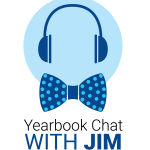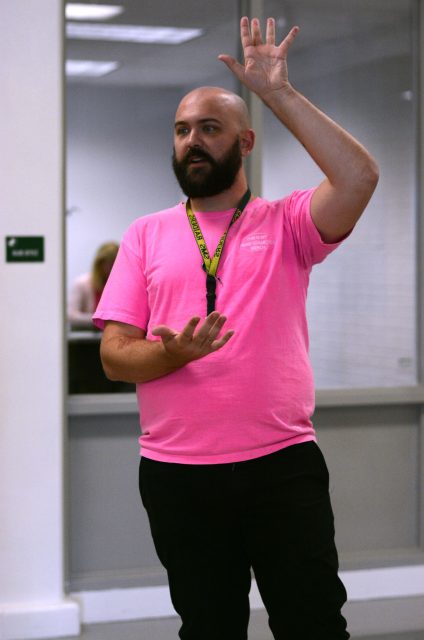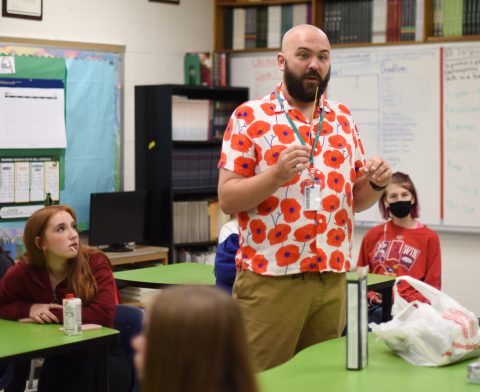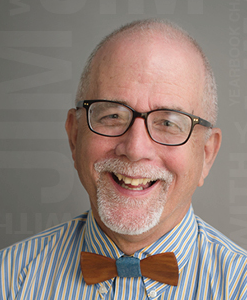 February’s Yearbook Adviser of Note is Tucker Love, from Shawnee Mission South High School in Shawnee, Kansas. Tucker is in his fifth year of advising the Heritage yearbook, and his staff were recently named NSPA Pacemaker Award finalists.
February’s Yearbook Adviser of Note is Tucker Love, from Shawnee Mission South High School in Shawnee, Kansas. Tucker is in his fifth year of advising the Heritage yearbook, and his staff were recently named NSPA Pacemaker Award finalists.
You can listen to our conversation on Yearbook Chat with Jim at walsworthyearbooks.com/podcasts or wherever you listen.
Profile
High school attended – Shawnee Mission North High School, Overland Park, Kansas
College attended + degrees and majors – I attended three schools before I officially graduated with my first degree. Initially, I went to the Kansas City Art Institute from 2012-2014 and studied Graphic Design. When I decided I wanted to change majors to education, I transferred to Johnson County Community College for the 2014-2015 school year to knock out some gen ed courses and then went to Kansas State University. After completing my student teaching at Shawnee Mission West with yearbook adviser Amy Morgan, I graduated in December 2017 with a B.S. in Secondary Education with a Journalism emphasis.
After starting my career at South, I started an online masters at Emporia State University. Honestly, I can’t remember what the years were because it bled into COVID times, but I did graduate with a M.S. in Curriculum & Instruction, Instructional Coach emphasis.
 Did you participate in journalism in high school?
Did you participate in journalism in high school?
I did! It all started with the 8th grade Northern Exposure night where incoming freshmen had an opportunity to tour Shawnee Mission North and hear about different electives and clubs. That night, I met Becky Tate and was intrigued by the beginning journalism class. I chose to enroll in beginning journalism my freshmen year. I can remember parts of the class, like my two friends that took the class with me and how Tate taught headline writing. I’m sure Tate encouraged me to do it, but I ended up transferring into yearbook for the second semester of my freshmen year and I wrote some mediocre stories by the end of March that were included in the 2009 Indian.
My sophomore year, I enrolled in photojournalism because I wanted to try something new. That also meant that I somehow became the Index Editor on what turned out to be the best editorial board ever (I’m a little biased.) We had no seniors to step up and lead the publication, so seven of us became an editorial board that developed the 2010 Indian. Somehow, I became our theme page editor and designed the typical theme pages and wrote copy. I don’t know whose idea that was, but I guess it worked out. That group of editors was an incredible bunch and we got to do it all over again the next year.
My junior year, I applied to be the Student Life Editor and I really dove into design. That’s where my skills really developed and by the time I graduated from North, I had decided to pursue graphic design in college. But that junior year was a great time. We had the same core group of editors working on the 2011 Indian, so it felt like a take-two. We did a lot of fun things like write crazy quotes all over a butcher-papered wall. I asked our co-EIC to prom through endsheet design ideas. We created a mock yearbook filled with notes for Tate. I watched Tate do the splits during a worknight which will forever stick with me.
And my senior year, I had the privilege to be Editor-in-Chief of the 2012 Indian. Honestly, I struggle to share many details from this year. It’s all a blur. I can tell you that Susan Massy from Shawnee Mission Northwest told me my original theme sucked and in a matter of 30 minutes, helped me come up with the theme we actually used — “Really.” I can tell you I got an ulcer my senior year because I took on too many things and wanted to do them all perfectly. Most importantly, I can tell you that being a part of journalism at North gave me a sense of purpose and duty, along with a community that helped keep me alive. I had a lot bottled up throughout my teenage years, and journalism (along with theater and music classes) saved me in many ways that I am forever thankful for.
Did you participate in journalism in college?
I did. As a secondary ed journalism major, I took numerous journalism courses. It wasn’t until my second year at K-State that I applied and was hired to be the assistant design editor for the 2017 Royal Purple. Essentially, I designed about one-third of that Royal Purple. It was an incredible opportunity and one that I thoroughly enjoyed.
What jobs did you hold after college before you became a teacher and a yearbook adviser?
About a week after graduating, I interviewed with principal Todd Dain for the SMS journalism adviser position. In early January, I was officially offered the position and signed on to start in August 2018. Between January and May of 2018, I spent time substitute teaching and working for Breakout KC, an escape room experience. In early February, Dow Tate at Shawnee Mission East asked if I would be interested in coming in to spend some time with his students in a consultant role, while also getting to know the staffs. Dow was scheduled for a late spring surgery and needed a long-term sub. Shortly after the 2018 Spring National High School Journalism Convention, I started as the temporary adviser at SME and helped the staffs finish two issues of The Harbinger. My very first yearbook distribution day as a yearbook adviser was at East where we passed out something like 1,400 books. Distribution day was the day after 50 yearbook kids and I opened nearly every yearbook and put a sticker in it to fix a caption. It was wild, and all I could think was “if I can do the SME yearbook distribution day, I can do anything.”
Details
Size of your book: 9
Number of pages in your book in 2022: 352
Number of pages in your book in 2023: 352
InDesign
Delivery: Spring
Student Population: 1,500
Number sold in 2022: 1,070
Awards for 2022 and previous books — Since my time as the SMS yearbook adviser, Heritage has received the KSPA All-Kansas rating for the 2019, 2020, 2021, and 2022 volumes. The 2021 Heritage placed 7th in Best of Show at the Philadelphia NSPA workshop and 6th place BOS at Los Angeles convention. The 2022 Heritage placed 5th place BOS at St. Louis. The yearbook staff has received the Quill & Scroll Blue & Gold Award for Photography for the 2021 and 2022 yearbooks. There have been a number of students who have received recognition for their work in the yearbooks between 2019 and 2022 from KSPA, JEMKC, Quill & Scroll and NSPA.
 Number of books you have advised at Shawnee Mission South High School including the 2023 book? This is my fifth yearbook and fifth year at South.
Number of books you have advised at Shawnee Mission South High School including the 2023 book? This is my fifth yearbook and fifth year at South.
Other schools you have taught and/or advised at? What years? Awards at previous school? Technically, I have not officially held the full-time yearbook adviser role at any other school. I worked with the 2017-2018 SME publication staffs when I was their spring long-term sub. I think both publications won some national awards, but let’s be real — my eight weeks there had very little to do with that!
Other classes you teach Shawnee Mission South: I teach 21st Century Journalism, Yearbook, Newspaper and Photojournalism. I also taught Writer’s Workshop during first semester and I have taught Video Production 1 in previous school years.
Other publications you advise: I advise The Patriot student newsmagazine, The Patriot Online, and Inscriptions literary magazine.
Questions
Where were you born and raised?
I was born in Kansas City, Missouri, and raised in the Shawnee and Merriam suburbs in Johnson County, Kansas. It wasn’t there when I was a child or in high school, but I grew up not far from the IKEA in Merriam.
What were you involved in during high school? How would you describe high school Tucker?
I did a lot of things in high school. There was obviously journalism, but when I wasn’t taking pictures or designing or writing, I was filling my time with a variety of things. I played soccer throughout high school. I was a stand-up bass player for our top orchestra Strolling Strings. I was Pep Club president my senior year. I was involved with theater productions both on stage and behind the scenes, made Thespian initiation my freshmen year, was on Thespian Exec Board my junior year and Thespian president my senior year. My schedule was generally filled with honors or AP classes as well as a lot of fine art and performing arts classes.
High school Tucker was super involved, probably to a fault. I had lots going on in my brain that I was trying to navigate on my own. It was 2008-2012 and while some things were improving regarding mental health, I think there was still a lot of stigma around admitting you might be struggling with something. My solution was to dive into every activity I could that gave me some kind of life. Theater, orchestra, journalism, art, soccer, pep club. I loved all these things, but I probably could have taken a step back from some of it all and just relaxed a little bit.
Where did you attend college? Were you involved in publications?
I spent time at three different colleges during undergrad: KCAI, JCCC and K-State. My degree is from K-State, and I was involved in publications during my last year in Manhattan. I was the assistant design editor and helped design about 1/3 of the book. The other 2/3 were designed by the design editor Morgan Steward and co-Editor-in-Chief Andrew Nevins.
 How and why did you decide to go into teaching?
How and why did you decide to go into teaching?
During my second year of college, I was a graphic design student at the Kansas City Art Institute. I loved design — I still do. But I was just having some struggles and feeling unsure about what I wanted to do with it long term. I realized I missed how I had used design to tell stories in yearbook. I could have done something like this professionally, but I think I somehow determined that telling the stories of high school students was more important. I wanted to be an adviser and work with high school students to produce yearbooks and newspapers that told the stories of a specific high school community.
It would be foolish of me to not include Marty Maxwell Lane in this story. Marty was one of my typography teachers. I was so nervous about leaving KCAI and stopping partway through a degree to pursue education instead. I said something to that effect in an office hours meeting and her response stuck with me — sometimes you have to difficult things that aren’t fun and suck in the moment, in order to arrive at the place where you will be happiest. I paraphrased the heck out of that because it’s been eight years, but that was the essential idea. It was okay to be nervous and worried about leaving something I enjoyed in order to go do something that would ultimately make me happier in the long run.
How and why did you first get involved with scholastic journalism? What were the circumstances around you becoming a yearbook adviser?
My first experience was as a student. Over the course of the five-and-a-half years it took for me to get my education degree, I did work closely with some of Becky Tate’s staffs at North in a consultant capacity, helping kids with proofing, story and theme development. As a professional teacher, it has always been my role.
After leaving KCAI, I always knew that I wanted to advise publications. Becoming the South yearbook adviser was something that felt like the stars and planets aligning. I student taught with Amy Morgan at Shawnee Mission West in the fall of 2017. During our trip to Dallas for the fall NHSJC, Julie Fales — the South adviser at the time — told me that she was planning to leave the adviser role to take over as South’s librarian and that I should consider applying for the yearbook adviser job. That was wild to me because I had always thought it’d be a dream to work in Shawnee Mission, but I thought it would be a while before the opportunity would present itself. To know it might be a possibility while still in my student teaching was wild. I was fortunate to interview with Todd Dain who saw something in me as a young adviser who would hopefully stick around for a long time and work to continue building up the program that Julie and those before her had made.
What was the most difficult part of your first year advising?
One thing I struggled with wasn’t necessarily yearbook related. One of the hardest things during my first year was trying to convince the students that I knew what I was doing as an adviser, and it seemed to be more difficult with my newspaper staff. That was a difficult thing to navigate, and I wasn’t ever sure if I really did a good job with newspaper. That newspaper staff was wonderful and did good work, but I always felt like I didn’t do them justice. I think five years in, I’ve figured out newspaper a little better and have been able to do a better job supporting that publication.
What made you want to come back for year two?
Two things stand out as I think back to that first year. First, the moment I watched my first yearbook EIC open a book of yearbooks and see the cover. Second, our end-of-year banquet when I felt myself start to choke up as I talked about the seniors getting ready to graduate.
One of the biggest reasons I teach is that I believe high school students succeed best when they have teachers who really care about them, what they have to say, and who they are and are becoming. I made it through high school because I had teachers who saw me and through their classrooms, were able to tell me that I could do so much. I think every high school student deserves to experience that and that is something that I try to take with me into every class I teach. That second moment felt like that coming through and I realized I was in the exact right place.
What advice would you give to a first-year yearbook adviser?
There are so many things. My first one is to make friends with the front office folks in your building. The athletics secretary, the attendance clerk, the bookkeeper, the nurse, the receptionists, the counselors (even though ours are downstairs from the office) — all of them. Generally, they know everything about what’s going on. Treat them kindly, bring them some candy or a baked good from the local bakery down the road every once in a while. Keep them close and let them know you appreciate everything they do for the school and for you and your kids. I don’t know how many times I’ve told students to “go ask the office” about something and they almost always come back with an answer that has helped them out.
What were some of the factors that have led your success as a yearbook adviser over the years?
I think one of the biggest factors in my advising life has been the connections to other advisers that I’ve been able to make. Kansas City is an incredible scholastic journalism city. Blue Valley, Olathe, Lawrence, North Kansas City schools, Lee’s Summit, Park Hill, Shawnee Mission. I know I’m forgetting more, but the ability to connect with the advisers and the work their students do has a huge impact on how I teach my own students. We look at those schools’ work when we get their yearbooks or newspapers. We check the KSPA monthly contest results or wait for the JEMKC annual contest results every April. I’m always thinking, how can I use these things to help my students get better. Being able to text or email people like Jim McCrossen, Julia Walker, Jessica Flowers, my Shawnee Mission cohort, and others is so valuable. When I have problems, these are some of the people I think of. I know they will have answers or thoughts or suggestions.
I think another factor that has helped me is therapy and how it’s reshaped my way of thinking about success and balance in my life. I worked on four Pacemaker-winning yearbooks in high school. My colleagues are award-winning advisers who have worked with publications for at least 20 years each. As a new adviser, I put a lot of pressure on myself to push myself and my students to produce award-winning publications and to be just like them. I had trouble managing that stress and self-induced pressure, which was made worse by a pandemic. Anxiety medication and therapy has significantly improved how I approach the work I do as an adviser and teacher. It’s work that matters immensely to me. I think it is incredibly important work that my students do. But it does not have to be perfect. It does not have to win awards. It does not have to be what I think it should be. It just has to be what the students want it to be. If they’re proud of the work they’ve done, then I think I’ve helped them succeed.
What has been your biggest challenge as a yearbook adviser?
Keeping my desk clean and organized. Also, students will always be challenging. They’re anywhere from 14 to 18 years old. Sometimes they’re younger, sometimes they’re older. They are always a challenge but that’s literally what we signed up for. Should I have to deal with some of the things I deal with from kids? Probably not. But at the end of the day, I chose to be a high school teacher and working with students and with their challenges is the job. So my best answer is truly keeping my desk clean and organized. It’s always a nightmare.
Tell me about something in your life as a yearbook adviser that has made you proud. Or something that keeps you going when things get tough and frustrating.
Some of my favorite memories as an adviser have been related to the times I have spent with Dow, Becky, Amy, and Susan. Surprising Becky when she won the H.L. Hall yearbook yearbook adviser of the year in the same journalism classroom I learned so much in. Receiving the KSPA sunflower award during my fourth-year teaching. Traveling to Chicago, Anaheim and Dallas with them. Sitting at Burg & Barrell after a Quill & Scroll initiation. Getting to share these experiences with them and my students is just more than I could have ever asked for. They are truly some of my favorite people in the world and I’ve probably already said it too many times, but I have learned so much from each one of them. I feel that so much of who I am as an adviser is a direct result of working with four of the best advisers in the country and that is such an honor.
Tell a story that is indicative of your life as an adviser. Tell a story about a moment in your career a a yearbook adviser that you will never forget.
This is a recent one, but I don’t think I’ll ever forget the moment I found out Heritage 2022 had been nominated for a Pacemaker. I knew the finalists were being announced, but I chose not to watch for a number of reasons. But when Aledo adviser Emily Arnold texted me “YAY!!!! Congrats, friend!!” I immediately knew what she was talking about. I didn’t believe her at first and was in a bit of shock, just sitting at my desk with a half-eaten sandwich in my hand. Then she sent a picture of the bright orange cover on the NSPA website and I just started to cry a little bit. Making these publications isn’t about the awards. It’s about telling the story of a community, and hopefully the kids making it learn something along the way about journalism and being a good human. They put in so much work to make the best book South had ever seen. So it felt nice to see that work get recognized at that level.





